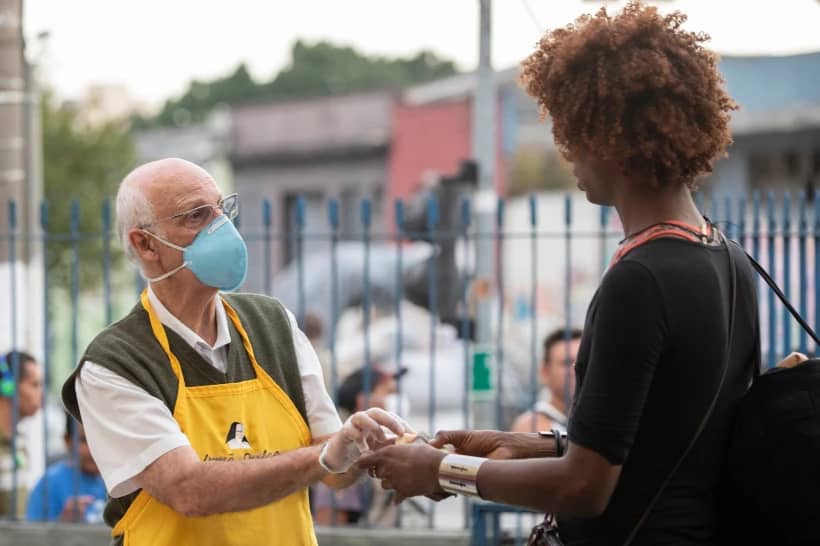SÃO PAULO — After being closed for four months, the National Sanctuary of Aparecida in Brazil partially resumed public Masses at the end of July. The strict health and safety protocols that limits the access to celebrations, however, have impeded most pilgrims from visiting the country’s most popular shrine.
With 12 million visitors every year, the sanctuary houses the image of Our Lady of Aparecida, a clay statue found in a nearby river by local fishermen in the 18th century. Over the years, the image became a national object of devotion and a city was created around the ancient church of Aparecida. The modern basilica began to be built in the 1950s.
From all parts of Brazil, devotees of Aparecida visit the sanctuary every year to fulfil a vow made to the Virgin Mary or to thank her for a much-needed grace. Packed buses and thousands of cars fill up the parking lots. Visitors usually congregate in large numbers in order to see the statue, to light a candle, or to buy a devotional medal. The COVID-19 pandemic changed everything this year.
“The impact was huge. Our city depends a hundred percent of the religious tourists. Giftshops, hotels, and 2,400 street vendors’ stands need them to make a living,” lamented Angelo Leite, president of the city’s commerce association.
Leite explained that the revenues usually double during the second half of the year. But now all shop owners seem to be “lethargic,” he said.
“Two months ago, the city government allowed us to reopen. But without tourists there’s no business. With the partial reopening of the sanctuary, nothing has changed yet,” he said.
The problem is that the safety measures established by the administration of the sanctuary along with the government decreed that only a thousand visitors can attend each celebration. The church can hold 30,000; other churches in the state can operate at 30 percent capacity.
“But we decided to adhere to an extensive set of measures, including the permission for only two persons per pew,” explained Father José Ulysses da Silva, one of the 30 Redemptorist priests that work at the sanctuary.
Workers and volunteers take the temperature of every person that gets into the basilica; people then have to clean their hands with sanitizers; after that they’re taken in line to a specific pew. During celebration, the priest goes to each person to give communion. Everybody is then conducted to the same exit door, once again in a socially distanced line.
“The same measures are applied for the other areas, such as the restrooms, the giftshop that is currently open, and the zone where people can see the image of Our Lady,” explained Da Silva. Everything was planned to avoid an agglomeration of people.
On the weekends, with a larger number of pilgrims, open air Masses are also celebrated. Every attendee must wear a face mask.
The administrators of the sanctuary have been asking through their TV and radio stations for people in high risk groups for COVID-19 to abstain from visiting during the crisis. In order to avoid crowds, buses are banned from the basilica.
With so many restrictions, the local businessmen still wait for an actual reopening, said Leite. In the city of 37,000 inhabitants, 80 percent of the economy is somehow connected to the sanctuary, Leite said.
“But if everything reopened now, Aparecida would become a vector of contagion, with people bringing and taking the virus with them. There’s no alternative, we’ll have to wait,” he acknowledged.
Valdevino Vieira, a resident of Limeira – a city 175 miles west of Aparecida – is also disappointed with the impossibility of visiting the sanctuary this year. Since 1986, he has organized an annual pilgrimage to the basilica.
For nine days around Easter time, he and other 250 men walk several miles a day carrying their supplies on their backs and sleeping in churches and public buildings. “It’s a kind of spiritual retreat,” he told Crux.
The event grew so much over the years that now Vieira and his colleagues run a non-governmental organization dedicated to its management and to social services directed to elderly people.
“At first, some of us thought we should keep the pilgrimage despite the pandemic. But things got worse. One of our longtime colleagues was infected and died. Everybody realized that we would be forced to postpone it for the next year,” Vieira said.
Some of the pilgrims of Vieira’s group – now there’s also a separate women’s pilgrimage – wait the whole year for the walk, which they dedicate to thank Our Lady of Aparecida for favors they attribute to her.
“Some people are coming to thank her for being cured of COVID-19. But many are begging for an economic relief,” said Da Silva.
The sanctuary’s patronal feast, celebrated on October 12, normally attracts up to 300,000 people to the basilica.
“This year, all celebrations will be carried out on-line,” Da Silva said.















